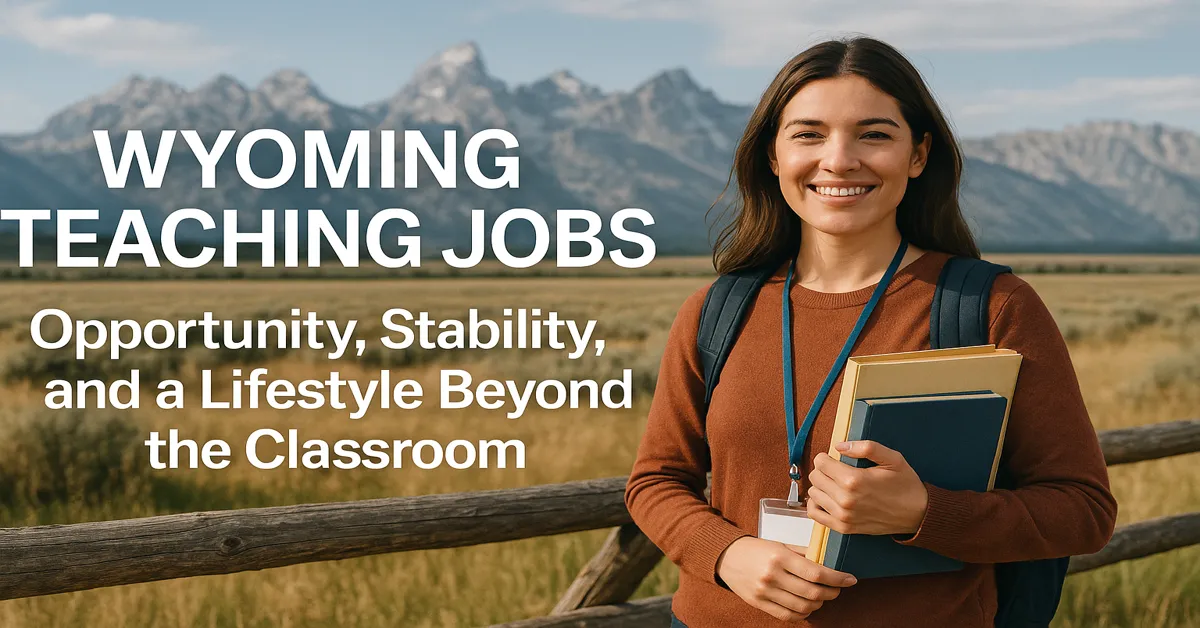If you’re considering a career in education or looking to relocate as a licensed teacher, Wyoming teaching jobs offer more than just employment—they offer a lifestyle. Nestled between vast open plains and majestic mountain ranges, Wyoming schools consistently rank among the nation’s best for teacher satisfaction, small class sizes, and above-average compensation. Whether you’re an aspiring educator or a veteran teacher searching for purpose and space, Wyoming’s education landscape deserves serious consideration.
This article serves as your complete, updated guide to teaching careers in Wyoming—covering licensure requirements, salary expectations, job availability, district culture, and the unique lifestyle educators enjoy across this expansive, low-density state.
Why Teaching in Wyoming Is Different
While many states struggle with overfilled classrooms, stagnant salaries, and waning public trust in educators, Wyoming continues to invest deeply in public education. The reasons are structural, financial, and cultural:
- State-Funded Stability: Wyoming’s school funding model is rooted in mineral and energy revenues. This allows for strong per-pupil spending without placing excessive burden on local taxes.
- Small Class Sizes: With fewer students per teacher, individualized instruction is more achievable.
- Low Cost of Living + High Quality of Life: From national parks to small-town safety, the personal advantages are clear.
- Community Support: Teachers in Wyoming often report higher levels of community engagement and parental cooperation than in more urbanized states.
Understanding the Job Landscape in Wyoming Education
Wyoming has 48 public school districts and one state-run virtual education program. While the state is geographically large, its total K-12 student population hovers around 90,000, making it one of the smallest systems in the U.S. in terms of size—yet among the most well-funded per student.
Most In-Demand Teaching Roles (as of 2025)
- Special Education
- Secondary Math & Science
- Elementary Education (rural districts)
- Career and Technical Education (CTE)
- English as a Second Language (ESL)
Hard-to-Staff Areas
Many rural districts, particularly in western and southeastern Wyoming, have persistent vacancies due to geographic isolation. However, these positions often come with relocation assistance, housing stipends, and hiring bonuses.
Licensure: What You Need to Teach in Wyoming
1. Basic Licensure
To teach in Wyoming, you must be licensed by the Wyoming Professional Teaching Standards Board (PTSB).
Requirements Include:
- A bachelor’s degree from an accredited institution
- Completion of a state-approved teacher preparation program
- Passing scores on Praxis exams for your subject area
2. Alternative Licensure Paths
Wyoming is among the states that offer alternative routes for career changers or those with teaching experience outside traditional pathways. For example:
- Intern Licensure Program: Teach while completing pedagogy coursework.
- Reciprocity: If you are licensed in another state, Wyoming may grant provisional or full licensure.
3. Substitute Teaching
With minimal requirements—a background check and some college credits—many use substitute teaching as an entry point into full-time work in Wyoming schools.
Salary Expectations and Benefits
Contrary to the image of rural austerity, Wyoming pays its teachers among the top 15 in the U.S. when adjusted for cost of living.
| Experience Level | Average Annual Salary |
|---|---|
| Entry-Level (0–3 years) | $48,000 – $53,000 |
| Mid-Career (4–10 years) | $55,000 – $65,000 |
| Veteran (10+ years) | $67,000 – $80,000 |
Additional Compensation and Perks
- Retention Bonuses in high-need districts
- Student Loan Forgiveness eligibility under federal rural school programs
- Robust Retirement Plans through the Wyoming Retirement System
- Health Insurance with low premiums and wide coverage
Some schools even provide district housing for teachers, especially in remote areas, eliminating one of the major financial concerns educators face elsewhere.
Day in the Life: Teaching in Wyoming
Teachers in Wyoming describe their day as balanced and flexible, with fewer bureaucratic interruptions and more meaningful student interaction.
- Classroom Sizes: Usually 12–20 students
- Daily Schedule: 7:45 AM to 3:30 PM (standard, with prep periods)
- Support Staff: Many schools have full-time counselors, aides, and specialists
- Technology: One-to-one student device programs are common across districts
The low student-teacher ratio allows for deep instructional focus and project-based learning—a major draw for educators seeking pedagogical freedom.
Where to Teach: Highlighting Key Districts
1. Teton County School District #1 (Jackson)
- High-performing, well-funded, and popular with relocating professionals
- Strong focus on bilingual education and sustainability
- Competitive salaries but high cost of living
2. Laramie County School District #1 (Cheyenne)
- Largest in the state
- Good balance between urban and suburban student needs
- Strong mentorship programs for new teachers
3. Fremont County School Districts
- Multiple districts with majority Native American populations
- Emphasis on culturally responsive teaching
- Higher turnover rates but strong incentives
4. Sweetwater County (Rock Springs/Green River)
- Emphasis on STEM and vocational education
- Rich community support for education
- Affordable housing and growing local economy
5. Remote Districts (Niobrara, Big Horn, etc.)
- Incentives include housing assistance, transportation stipends
- Ideal for self-directed educators seeking community involvement
Cultural and Geographic Perks of Teaching in Wyoming
Outdoor Lifestyle
From Yellowstone National Park to the Wind River Range, weekend adventures are practically embedded into daily life. Many schools even integrate outdoor education into their curriculums.
Community Engagement
Towns rally around schools. Teachers often serve as coaches, mentors, or club leaders—earning respect and genuine influence in their communities.
Low Crime and High Safety
Most Wyoming communities rank among the safest in the country. That peace of mind extends into the classroom.
Technology and Innovation in Wyoming Classrooms
Despite its rural image, Wyoming has rapidly modernized its educational technology infrastructure.
- Statewide broadband initiatives
- Virtual learning programs—particularly for AP and niche subjects
- Career tech pathways tied to local industries like mining, renewable energy, and agriculture
- STEM enrichment partnerships with University of Wyoming and local colleges
These efforts help teachers access tools and professional development typically reserved for larger urban districts.
Professional Development and Growth
Wyoming encourages continuing education through:
- Funded graduate courses via the Wyoming Teacher Shortage Loan Repayment Program
- Summer teaching fellowships in science, literacy, and environmental education
- Annual state conferences on pedagogy, diversity, and rural education practices
Mentorship programs are common, particularly for new teachers, ensuring that educators are not left to “sink or swim.”
Living and Teaching in Wyoming: Challenges to Consider
No teaching opportunity is without its hurdles. Here’s what to know:
Geographic Isolation
Some towns are several hours from major cities. This isolation may impact social options or family logistics.
Limited Cultural Amenities
Larger towns like Jackson or Cheyenne offer arts and dining scenes, but small districts may have few entertainment options beyond nature and local events.
Recruitment Turnover
Rural schools often face higher turnover. Stability varies district by district.
Weather Extremes
From snowy winters to arid summers, Wyoming’s climate can be challenging for those unfamiliar with seasonal extremes.
Still, for many, these challenges are offset by the state’s quiet, beauty, and supportive teaching environments.
How to Find Wyoming Teaching Jobs in 2025
Most Wyoming teaching jobs are posted through:
- Wyoming School Boards Association (WSBA) Job Board
- Wyoming Department of Education
- Individual District Websites
- Education-specific job boards like SchoolSpring and K12JobSpot
Applicants can apply year-round, though March to May is peak hiring season.
What Makes a Great Candidate in Wyoming?
Successful Wyoming teachers tend to embody:
- Resilience and independence
- Cultural responsiveness
- Flexibility across roles (teacher, coach, mentor)
- Passion for community-building
Bringing outdoor experience, agricultural knowledge, or tech skills can further boost your candidacy—especially in districts seeking enrichment beyond core academics.
Voices from the Classroom: Testimonials
“I came to Wyoming thinking it would be a short stop. Eight years later, I’m still here, teaching 4th grade, raising my family, and loving it.”
—Melissa R., Sublette County
“The small classes mean I actually teach. Not crowd control—real, deep, satisfying instruction.”
—Luis T., High School Math Teacher, Cheyenne
“I left California burnt out. Now I teach full-time, hike on weekends, and finally feel respected in my role.”
—Danielle K., Special Education, Lander
Conclusion: Is Wyoming Right for You?
Wyoming teaching jobs aren’t just about employment. They’re about connection—to community, to nature, and to a calling that is increasingly hard to find in more congested, standardized settings. For those who want their work to matter—and want room to live while doing it—Wyoming offers a rare and promising path forward.
With competitive pay, strong funding, and some of the most stunning landscapes in the U.S., the state is quietly building a future where education thrives—not in spite of its rural identity, but because of it. (Wyoming Teaching Jobs)
FAQs
1. Do I need a Wyoming teaching license to teach in the state?
Yes. All full-time teachers must be licensed through the Wyoming Professional Teaching Standards Board (PTSB). However, if you hold a valid license in another state, reciprocity options may allow you to teach while completing Wyoming-specific requirements.
2. Are there alternative certification options for those without an education degree?
Yes. Wyoming offers alternative routes such as the Intern Certificate, which allows you to teach while completing required coursework. This is ideal for career changers or professionals with subject matter expertise but no formal teacher training.
3. What are the most in-demand teaching positions in Wyoming?
Currently, special education, secondary math and science, career and technical education (CTE), and elementary education in rural areas are the most sought-after teaching roles statewide.
4. How much do teachers in Wyoming typically earn?
Starting salaries range from $48,000 to $53,000, with mid-career professionals earning $55,000 to $65,000, and experienced teachers earning up to $80,000, depending on the district and qualifications.
5. Are there financial or housing incentives for teachers in remote districts?
Yes. Many rural and hard-to-staff districts offer hiring bonuses, relocation assistance, student loan forgiveness eligibility, and in some cases, district-provided housing to attract and retain teachers.











